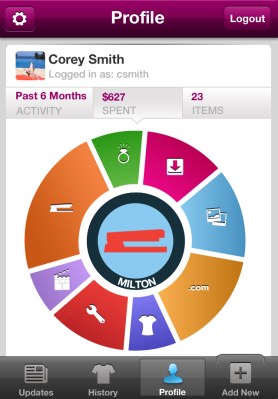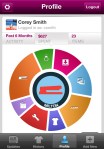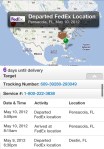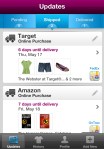Don’t let their recent quiet streak fool you — the team at Eric Schmidt-backed receipt aggregator/tracking service Slice have spent the last few months slaving away on revamped versions of their iOS and Android apps, and now that major update is ready for the purchase tracking masses.
With Slice 2.0, co-founder and CEO Scott Brady wanted to do more than just track packages and aggregate users’ purchase histories. Perhaps the most notable addition to the updated Slice mobile apps is a new personal analytics option called Thingerprint that breaks down how much users have spent on what kinds of products, with options to drill into specific purchase categories, item types, and merchants.
Naturally, most of my paycheck goes toward gadgets and other similarly shiny new things, so Slice’s Thingerprint has branded me a “Gadget Geek.” It may not be the most original addition to the mix — rivals Lemon and OneReceipt have taken a similar approach — but having a fairly comprehensive breakdown of your purchasing habits at your fingertips isn’t the sort of thing most users would turn their noses up at.
While the addition of personal analytics adds another dimension to the service, some of the updated bits were just about making Slice more accessible to particular use cases. During Slice’s early days for instance, the service could only connect to and scan Yahoo! And Gmail accounts for emailed receipts and tracking notifications.
Not so any more — Brady and his teamed fleshed out Slice 2.0 with support for iCloud, Hotmail, and AOL email accounts. Also featured prominently is the ability to manually add a new purchase to your Slice account by scanning the barcode off of a packing slip, though it should be noted that the Android version requires users to download a separate scanner app for that feature to work properly.
Some of the additions included in this most recent update may seem like no-brainers, but the process wasn’t always that straightforward. Brady confirmed to me that there was plenty of thoughtful testing and retesting before he and team signed off on the final updates.
“The focus groups give us ideas on where we like to take our capabilities,” he said “We rely pretty heavily on them, and before we go too far on any product we do plenty of testing and tweaking.”
For what it’s worth, his approach seems to be working so far. Since Slice’s launch in May 2011, the service has processed and tracked over 25 million purchases, and that number is sure to grow even larger if the company eventually gives in to their users’ demands.
“Behind additional email support, global availability is the second most requested feature,” Brady remarked. “Today we only support the U.S., but we’ve created a technology that can work throughout the rest of the world.”





